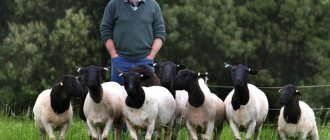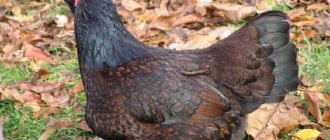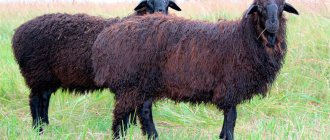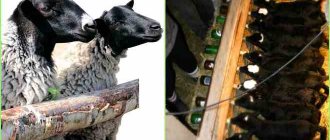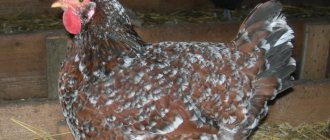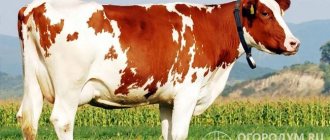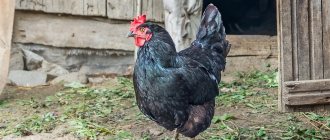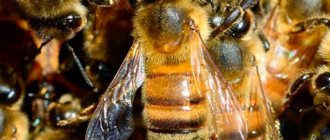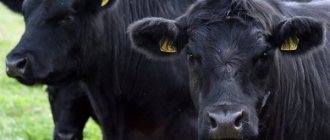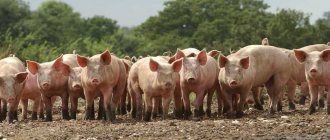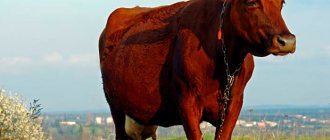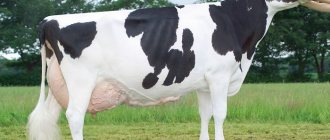Origin of the Romanov breed
In the second half of the 18th century, the formation of the Romanov breed, obtained on the basis of northern short-tailed sheep through long-term selection aimed at increasing fertility and improving the quality of sheepskin, was completed.
Sheep of the Romanov breed
According to historical documents, its place of origin is the peasant farmsteads of the city of Romanov, Romanovo-Borisoglebsk district, Yaroslavl region.
When kept in small groups on peasant farms on the Volga water meadows, a new highly productive Romanov breed was fed and formed.
Now the Yaroslavl region is a breeding center and the main supplier of breeding animals.
Conditions of detention
The initial task of the founders of the breed was to cultivate such qualities as unpretentiousness, adaptability to different natural conditions, good productivity with a meager diet. This is exactly what the Romanov breed of sheep became. The price for animals is quite reasonable. Keeping it at home is not a hassle, so this kind of livestock farming is convenient as a starting business. It requires almost no investment. But there is one important point: sheep farming requires a large pasture, since sheep practically cannot stand being kept in stalls.
This breed is unpretentious to temperature and other climatic changes. Sheep feel great both in heat of 30 degrees and in frost. So you don’t have to worry about them, no matter what the weather is like outside. It is thick sheep wool that is a universal temperature regulator, which has no analogues in the world. In winter, your flock will need thick, dry bedding, and in summer, daily grazing on green meadows.
Description of Romanov breed sheep
Based on the shape of the tail, they belong to the group of short-skinny-tailed sheep - fat is not deposited on the mobile tail, consisting of 8–12 vertebrae.
Productivity direction: coarse-haired. Type – sheepskin fur coat. The ears are short. Color grey.
Characteristic types of constitution:
| Type | Description | Advantages | Flaws |
| Strong | Harmonious physique. The skeleton, muscles and adipose tissue are moderately developed, the skin is thin and dense | Good health, high quality sheepskin. Better meat and milk productivity. | |
| Gentle | Refined bones, thin skin. The limbs are placed close together. Representatives are characterized by lopsidedness | Good meat quality | Poor health, low quality sheepskins, sparse wool |
| Rude | Strong bones, rough skin. Rams often have a mane | Large animal size. Thick coat | Sheepskins are heavy. There is a lot of awn in wool |
Animals with a strong constitution bear strong and healthy lambs.
Difference in performance
Representatives of this type of sheep are divided into three groups:
- with rough bones;
- with strong bones;
- with delicate bones.
Each group has its own characteristics.
Sheep with delicate bones are less fertile and tenacious, their productivity leaves much to be desired. These animals have a narrow chest and head, sharp withers. The bones are underdeveloped, and the coat contains too much fluff in proportion to the hair, which leads to the fact that the fluff easily falls off. And although their fur is very beautiful, snow-white, these individuals practically do not participate in breeding. Large-boned sheep They have the best wool quality; it is most valued in the fur industry. Representatives of this variety have a wide chest, a thick coat of gray, sometimes slightly bluish color. They are the most tenacious and unpretentious.
The latter type of these sheep has heavy bones and coarse wool. Their hair is longer than fluff, their sheepskin is rough and ugly, but the animals demonstrate the best indicators of endurance, fertility and vitality. Therefore, they are often bred in rural areas.
Productivity of Romanov breed sheep
Individuals are distinguished by high milk, meat, wool and sheep productivity.
Sheep characteristics:
| Floor | Live weight (kg), average classes | Live weight (kg), elite class | Wool clipped (kg) | Fertility of queens (per head/lambs) | Milk production per 100 days of lactation (kg) |
| Rams | 60–70 | 100 | 2,5–3 | ||
| Uterus | 40–50 | 90 | 1,5–1,8 | 3–3,5 | 160–220 |
Unlike other breeds, highly productive Romanov sheep have a more intense metabolism. Therefore, they have an increased need for nutrients.
Milk production of Romanov sheep
Sheep milk is used to prepare fermented milk products and high-quality fatty cheeses.
Chemical composition of milk from Romanov sheep (%):
- dry matter: 17–19;
- milk fat: 6.3–7.3;
- lactose (milk sugar): 4.5–5.1;
- protein: 5.2–6.2;
- calcium: 0.16–0.19;
- phosphorus: 0.1.
Cow's milk, containing on average 3.5% fat, 3.2% protein, 12.5% dry matter, is significantly inferior to sheep milk in nutritional value.
Be sure to read:
Sheep barn: choice of material, step-by-step construction instructions, room arrangement
Meat productivity
Meat productivity is high - up to 250 kg of lamb per year is obtained from one sheep by fattening its offspring (5-6 lambs).
The slaughter yield of the carcass is 46–47%. The proportion of pulp is 60–70%.
Calorie content of 100 g of lamb meat is 272 kcal. Lamb fat contains almost three times less cholesterol than pork or beef.
Wool and sheepskin
Sheepskins are valued for their durable flesh and lightweight wool.
Sheep milk is used to prepare fermented milk products and high-quality fatty cheeses
Mesdra is distinguished by a reliable interweaving of collagen and elastic fibers , due to which very thin sheepskin stretches well. The weight of one sheepskin is 500 g.
Elastic fur does not wrinkle or fall off. Coat length is from 2.5 to 5 cm.
Romanov sheep, unlike other representatives of coarse-wool breeds, have heterogeneous wool - black hair with white undercoat. Due to the fact that the hair is colored differently, the coat turns out to be gray. The down is 2–3 cm longer than the spine.
Romanov sheep are sheared 3-4 times a year, trying to do so before the onset of molting. Coarse wool is used to produce felted shoes.
Keeping the Romanov breed of sheep
Romanov sheep are raised in small groups in pasture-stall or stall-walk conditions. Despite the fact that animals adapt well to severe frosts and cold, they cannot tolerate dampness and drafts.
The stall-pasture system is most suitable for keeping Romanov sheep.
Damp and swampy areas are unsuitable for grazing - here animals are often affected by foot rot and helminths.
If there are no winter pastures, and the farm is able to provide itself with feed, a stall-walking system is used - animals are kept in sheepfolds and fed on feeding grounds. In the fresh air, sheep absorb feed better.
Depending on the climate conditions in the region, sheep are fed on pasture for 170–200 days, and in the stall for 150–180.
Flocks are formed from culled queens and females and put into fattening. Concentrates are given up to 400 g per head. Provide water twice a day.
Adult care and maintenance
In winter, food is placed in the feeders ad libitum.
Flocks are formed from culled queens and females and put into fattening
The hay is placed in the manger. The feeding front is 0.25 m per head of an adult sheep, 0.15 m for a lamb. Make sure that the animals do not crowd and are distributed evenly along the feeder.
Feed distribution mode in winter:
- from 7 o’clock – concentrates;
- 7 hours 30 minutes – succulent feed;
- 10 a.m. – second supply of succulent feed;
- 11 a.m. – drinking water;
- 12 hours – succulent feed;
- 17 h – roughage.
Water is poured into troughs, the height of the side of which is 30–40 cm. Watering is done 1–2 times a day. The drinking front is 0.25 cm per head.
Romanov sheep have adapted well to grazing. They can graze even on poor pastures and digest all grass well. Sheep of this breed suffer from prolonged stay in stalls.
Be sure to read:
How much does a sheep weigh on average: live, after cutting or one year old, carcass slaughter weight and offal yield
Care and maintenance of young animals
Lambs are born with a smooth black coat consisting of a single awn , with white markings on the head, legs and tail. At the age of 1–3 months, the coat acquires a uniform gray color.
During the grazing period, grass predominates in the diet of young animals; during the stable period, hay and silage predominate. The best concentrated feeds for lambs are oat and barley groats.
Feeding lambs:
| Age | Feed (kg) | ||||
| Hay | Straw | Silage | Concentrates | Pulses | |
| From 8 months to 1 year | 0,5–1 | 0,5–0,7 | 1–2 | 0,2–0,25 | 0,1 |
| From 1 year to 1.5 years | 0,5–1 | 0,5–0,8 | 1,5–2,5 | 0,1–0,15 | 0,05–0,1 |
From two weeks of age, lambs begin to be offered hay and green leaves of twig food. Concentrates are introduced into the diet at the 4th week of life. They are released to pasture at the age of 20–30 days.
Weaning of young animals from their dams at the age of 3.5–4 days is accompanied by increased feeding of the lambs:
- concentrates – up to 300 g;
- hay – up to 2 kg;
- succulent feed – up to 2.5 kg.
Feeding – 4 times a day.
Diet for sheep kept in stalls
For 1 sheep, the following is prepared for the winter: up to 250 kg of hay, up to 500 kg of silage, up to 30 kg of concentrates.
Romanov sheep are unpretentious in feeding
The basis of feeding during stall housing in winter is roughage - hay and straw. It is also necessary to prepare branch food.
Romanov sheep are unpretentious in feeding - they willingly eat food waste and boiled potatoes, which in households often replace expensive concentrated feed.
Juicy feeds include silage and root vegetables, which are especially useful for pregnant queens.
Mineral supplements required per year per head:
- chalk – 1.5 kg;
- salt – 2.5–3 kg;
- bone meal – 2 kg.
At home, making silage will be no more difficult than fermenting cabbage.
To do this, take green grass, chopped potatoes and root vegetables, green vegetables, cabbage leaves. Everything is placed in a barrel, compacted and filled with whey - 1 bucket per 200 kg of green mass.
Lactic acid fermentation continues in a warm place for 4–5 days , then the barrel is removed to a cold room. The shelf life of succulent food is two weeks.
The main advantage of the Romanov breed is the ability to produce very high-quality sheepskin.
Good silage has a sweet and sour taste, a yellowish-green color and the smell of soaked apples. Improves the digestion of animals and increases the milk production of ewes.
When compiling the diet of pregnant queens, age and nutritional status are taken into account.
Feed for pregnant queens (kg):
- hay: 0.7–1.5;
- straw: 0.5–0.6;
- silage: 0.2–0.3;
- concentrates (corn, oats, grain, barley, mixed feed): 0.2–0.35.
For young and poorly nourished queens, the amount of feed is increased by 15%. The silage must be of good quality.
Feeding sheep with offspring (kg):
- In the first half of the suction they give: hay (1–1.5), straw (0.5), silage (4–5), concentrates (0.3–0.45).
- In the second half - hay (0.5–1), straw (0.5), silage (4.5–5), concentrates (0.2–0.3).
Be sure to read:
Breeds of sheep for meat production: characteristics and indicators of the largest rams
During the rest period, rams are fed ad libitum with hay and silage and given concentrates.
6–8 weeks before mating, the following is introduced into the rams’ diet (kg):
- best hay (legumes, meadow forbs): 1.2;
- silo: 2;
- carrots: 2;
- mixture of oats, millet, cake and barley: 1.5;
- eggs;
- milk;
- salt;
- mineral supplements.
A sheep's winter daily diet can consist of 1.5–2 kg of hay, succulent feed up to 2 kg, 1 kg of boiled potatoes and concentrates – 200–300 g.
Description of appearance
The ram is a cloven-hoofed animal. Average height can vary depending on the species from 1.4 to 1.8 meters, and weight, respectively, from the smallest 25 kg to 180 kg.
Typically, a male is called a ram, and a female is called a sheep. Her physical parameters are much lower than those of the male. The young ones are called lambs.
The ram has high and strong legs, adapted for long walks across the mountains and plains in search of food.
A ram's tail can be long or short or fat-tailed. Not only the tail, but also the fat tail itself can be fat-tailed.
They have lambs and horns. They can be twisted and reach up to 180 cm. There are rams and hornless ones.
Some species have a hooked nose. The ram's eyes have the unique ability to see without turning their head, which helps them avoid danger. They have good hearing and can smell.
Sheep communicate with each other using sounds. This helps them promptly notify the herd of the presence of food or an enemy.
In households, it is preferable to breed and keep hornless males, as can be seen in the photo of sheep, and there is a need for this.
The female is noticeably smaller in size than the male. The coloring of all is almost identical and belongs to a specific species: white, gray, black, red, brown.
Wild representatives are subject to molting, and the domestic species is subject to haircuts.
The ram is a shy animal that leads a herd lifestyle and communicates through bleating. The lifespan of a ram ranges from 7 to 15 years.
Advantages and disadvantages of the Romanov breed of sheep
The meat of Romanov sheep has valuable taste and, in addition, the unique and unique pleasant taste and aroma of
Romanov sheep was successfully used for a single introductory crossing to obtain a multiparous type of Karakul sheep.
Advantages of Romanov sheep:
- high commercial quality of sheepskin;
- multiple births;
- precocity.
Flaws:
- unstable type of nervous system;
- poor disease resistance, especially on large commercial farms;
- tendency to a slow viral disease - pulmonary adenomatosis;
- predisposition to scrapie disease (pruritus);
- weakened constitution.
Due to their economically useful qualities, Romanov sheep are better suited than other breeds for breeding in industrial conditions on mechanized farms.
The second product is meat
Of course, you won't keep sheep just for the milk. A large offspring implies periodic renewal of the breeding herd, and the rest of the livestock is sent to the market. Sheep of the Romanov breed are sold both as live heads, for breeding, and as carcasses, for meat. It depends on how exactly your business is structured.
The meat of sheep of this breed is highly valued in the market. It has excellent taste, as well as a unique aroma and taste. The yield of meat products is approximately 50% from each carcass. The meat of seven-month-old lambs is highly valued on the market; connoisseurs use it for kebabs and pilaf, preferring it to other types of meat. At this age they weigh about 40 kg, half the weight per carcass, which means you get about 11 kg of pure pulp. If you consider that a kilogram of kebab made from such pulp will cost about $200, then, as you can see, breeding Romanov sheep is quite a profitable business.
However, we have so far talked about the most delicious product - young lamb. How much does an adult weigh? From 80 to 100 kg - a ram, and approximately 75 kg - a sheep. Accordingly, the carcass comes out to be from 35 to 50 kg, which is a very good indicator. A well-fed ewe usually produces at least three lambs per lamb, each weighing about 4 kg.
The most common diseases of Romanov breed sheep
Sheep of the Romanov breed almost never suffer from tuberculosis.
Raising Romanov sheep for meat is quite a profitable business
The most common diseases:
- brucellosis;
- scabies;
- smallpox;
- foot rot (necrobacillosis);
- mastitis;
- helminthiases.
The main preventive measures are to maintain good nutrition of animals, as well as disinfection of premises and equipment.
The premises are regularly cleaned of manure and dust, the walls are whitened with lime milk. The first disinfection is carried out before placing animals in the sheepfold, the next ones - before lambing.
Brucellosis is a common disease in humans and animals. A sick sheep must be isolated from others and a veterinarian must be called.
Possible difficulties in care
Animals of the Romanov breed are resistant to many diseases. But some diseases arise as a result of improper maintenance and untimely vaccination. Most often, dampness, drafts, and poor-quality water can be observed in the room.
The detection of certain symptoms in individuals provokes the need for immediate removal. Through such actions, the development of the disease is stopped.
If the animal shows symptoms, you should study the description of the possible disease. To begin with, jigging is carried out and a veterinarian is invited. He makes a diagnosis and prescribes treatment. Often the cause of poor health is poor nutrition. If you don't steam the straw, you may experience stomach problems. Gastrointestinal diseases have negative consequences, including death.
There are infectious diseases that require competent, prompt treatment.
Bronchopneumonia
Sheep are prone to respiratory ailments. Improper maintenance - dampness in the room, lack of walking or ventilation, change of deep bedding - is manifested by poor health of the animal, the lungs and bronchi are affected.
The flow is acute and fast. Often leads to death (due to lack of treatment). If such a pathology is detected in several individuals, you need to check the humidity level in the room, begin ventilation, analyze the diet, and try to organize periodic walking.
Vitamin deficiency and leptospirosis
There are several types of vitamin deficiency. It is based on an incorrect diet, a complete lack of balance and vitamin intake. Often the emphasis is on acidic foods. Such nutrition provokes the entry into the body of a minimum amount of necessary elements. The cause may be a lack of sunlight.
Leptospirosis is a common disease of infectious origin. The carriers are sick animals, rats. The occurrence can be prevented through competent disinsection (systematic). The manifestation of pathology is based on non-standard behavior and intense weight loss. Diagnosed by tests. The treatment process is medicinal.
Smallpox and enterotoxemia
Today, smallpox occurs when there is an infection in an enterprise. It appears quite actively. A rash forms, later scabs. Damage to joints, eyes. We need to act quickly. In the first days to establish the problem, infected individuals are removed separately. A veterinarian is called in and an inspection is carried out. An untimely reaction can cause the death of the ewe and the entire livestock.
Enterotoxemia is an infectious lesion. The flow is very fast and sharp. Death comes suddenly. Treatable. The animal should be removed in a timely manner. The cause of serious pathological processes is toxins of vapor-forming microbes.
Mastitis and necrobacteriosis
Mastitis affects nursing queens, lambs, and goats. The cause is bacterial. Development can be prevented through proper care and avoiding the formation of dampness. The substrate should be systematically replaced to prevent the formation of dirt in the stall.
Necrobacteriosis is a dangerous disease. Initially diagnosed through livestock monitoring. The animal begins to limp. Erosion, cracks, ulcers, and skin breakdown gradually develop (severe form of the disease). It even affects the larynx, lips, and esophagus.
Peculiarities of breeding Romanov sheep
The economically useful advantages of Romanov sheep can only be preserved through purebred breeding.
For breeding, fertile animals with a strong constitution and high meat and fur productivity indicators are selected.
At 12–18 months, when the live weight reaches 35–38 kg, the yarka is ready to produce offspring. Pregnancy (gestation period) lasts 5 months.
The duration of the reproductive period is 5 lambings. The more lambs in lambing, the higher the milk production of the uterus.
Romanov sheep are characterized by high fertility - 2–4 lambs per lambing.
One ewe produces two offspring in a year or three in two years. This quality is due to the fact that Romanov sheep come into heat throughout the year.
A few secrets of popularity
Today, Romanov sheep and their breeding in peasant and farm households have gained well-deserved popularity. Often, even city dwellers and residents of suburban villages began to breed these sheep. There are several reasons for acquiring such popularity and they are undeniable.
- This breed is most suitable for quickly increasing livestock due to its high fertility. One ewe can produce from 3 to 6 lambs in one litter.
- Thanks to the thick sheepskin, it is possible to keep sheep in unheated rooms even during severe frosts, which reduces the cost of keeping them.
- They grow quite quickly, which allows you to get meat in 6-8 months, and sometimes even faster. By the age of 11-12 months, a ram can reach 70-80 kilograms.
- Raising these animals requires little feed, which makes it possible to keep them even in urban conditions, for example, in a country house. Sheep, if necessary, are able to feed on pasture, including leaves, moss, dead grass, and coarse straw.
- Puberty begins early: already by 4–5 months. Yarka is sexually active throughout the year, which also allows you to increase your population very quickly.
- Romanovka meat, sheepskin, wool and milk are highly valued due to their high qualities.
Where to start for a person who decides to breed sheep of this beautiful breed?
First, you need to decide what you would like to receive from your animals? Will you focus on getting offspring? Or is it important for you to raise sheep only for your personal needs in the shortest possible time? Or maybe you want to engage in sheep farming to obtain milk and make products from it? A correct understanding of your goals will help you decide:
- how many heads should you purchase;
- what feed to buy, and in what quantity;
- Is it necessary to build premises for keeping and lambing queens or are the simplest sheds sufficient?
To provide one average family with meat, milk and wool (without selling products), it is enough to purchase 3-4 queens and one ram! If your goal is to obtain products and sell them on the market, then you should start with at least 10 queens and 1-2 rams. Based on this, it will be easy for you to calculate the size of the desired premises for keeping sheep.
The next important step is purchasing animals. It is more advisable to purchase adult individuals, because even by their appearance it is easier to select the animal you need. Buying young animals is, of course, cheaper, but there is a risk here - it is unknown how the little one will show itself in terms of productivity in the future. But before you start buying animals, prepare premises for their maintenance and food.
